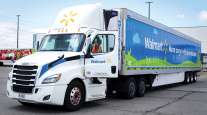Tight Capacity Starts to Squeeze Private Fleets, Executives Say
This story appears in the April 26 print edition of Transport Topics.
CINCINNATI — A strengthening freight market is leading to higher freight rates, and more loads are going unclaimed, attendees at the National Private Truck Council’s annual management conference said.
Vince Biondo, vice president private fleet for Wal-Mart Transportation LLC, Bentonville, Ark., said he was “starting to feel” capacity constraints.
“It’s shifting to a carrier environment,” he said. “If the economy continues to expand and prices rise, it’s possible that we might slip back into a capacity shortage.”
Michael Cole, director of North America Transportation for Kraft Foods Inc. in Northfield, Ill., said private fleets may be asked to haul more goods if common carrier rates surge.
Cole said the company also is working with customers and suppliers, as well as “noncompetitive” food haulers, to share space on trailers for products moving from more than 400 locations in the United States and Canada.
Kraft spends about $1.2 billion on transportation services each year. Besides its own fleet of 210 tractors and 680 trailers, 235 tractors are supplied by dedicated contract carriers and Kraft uses the services of 285 for-hire carriers.
Declining freight rates during the recession made it “challenging” for many private fleets to compete with for-hire carriers, Cole said. Some of those carriers now are beginning to reject loads and are expected to raise their rates rather than to expand their fleets as freight demand grows.
“Some carriers are at 120% of capacity now,” Cole said in a presentation on April 20.
NPTC President Gary Petty said that private fleet managers are “upbeat and positive” about business prospects.
About 60% of fleet managers recently surveyed by NPTC plan to increase their fleet’s size in the next 12 months, adding 13% more power units, on average, and handling 15% more of the freight for their corporate parent.
These data are based on the preliminary results of a benchmarking survey scheduled for release in August.
“This is the new normal,” said Tom Moore, vice president of education for NPTC. “Private fleets that are on top of their operations are able to grow.”
Larry Ahlers, vice president of transportation for Oldcastle Architectural Inc., Atlanta, said he is seeing significant volume shifts in the market.
“Capacity is a big deal,” Ahlers said during an April 18 presentation, “because if you don’t have a truck, you’re not hauling anything.”
Ahlers said he had projected a 15% decline in capacity, but since business has fallen off by 24% over the past year, the pain associated with a capacity shortage has not yet been felt by Oldcastle.
“That’s going to change,” he said. “We’re going to have a driver shortage out there.”
The Internet Truckstop said its market demand index, which measures the availability of loads and trucks, has been rising since January. The index reached 11.82 the week of April 12, up 5% from the week before.
An index above seven indicates there are more loads available than trucks and is considered favorable for freight rates, the company said.
Wal-Mart’s Biondo said that one way private fleets can offer more capacity is to solicit backhauls when their equipment is empty.
By doing that, he said, Wal-Mart has managed to reduce the percentage of empty miles it runs from close to 30% to 25.5% of total miles. The company also has reduced miles per load and increased the average volume of freight in each trailer.
Wal-Mart also is increasing its use of intermodal transportation and has begun to add refrigerated trailers to its fleet, which comprises 6,900 tractors and 54,500 trailers and is used primarily to deliver goods from Wal-Mart distribution centers to retail stores.
Biondo said Wal-Mart has separate distribution networks for general merchandise, dry groceries, perishables, returns and claims, and clothing.
“We’re working to optimize the entire network,” Biondo said.


